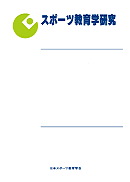35 巻, 2 号
選択された号の論文の9件中1~9を表示しています
- |<
- <
- 1
- >
- >|
原著論文
-
2015 年 35 巻 2 号 p. 1-16
発行日: 2015/11/30
公開日: 2016/04/12
PDF形式でダウンロード (643K) -
2015 年 35 巻 2 号 p. 17-28
発行日: 2015/11/30
公開日: 2016/04/12
PDF形式でダウンロード (374K)
研究資料
-
2015 年 35 巻 2 号 p. 29-41
発行日: 2015/11/30
公開日: 2016/04/12
PDF形式でダウンロード (602K)
日本スポーツ教育学会 第35回大会報告
-
2015 年 35 巻 2 号 p. 43-48
発行日: 2015/11/30
公開日: 2016/04/12
PDF形式でダウンロード (136K) -
2015 年 35 巻 2 号 p. 49
発行日: 2015/11/30
公開日: 2016/04/12
PDF形式でダウンロード (80K) -
2015 年 35 巻 2 号 p. 51-55
発行日: 2015/11/30
公開日: 2016/04/12
PDF形式でダウンロード (324K) -
2015 年 35 巻 2 号 p. 57-61
発行日: 2015/11/30
公開日: 2016/04/12
PDF形式でダウンロード (109K) -
2015 年 35 巻 2 号 p. 63-71
発行日: 2015/11/30
公開日: 2016/04/12
PDF形式でダウンロード (230K) -
2015 年 35 巻 2 号 p. 73-89
発行日: 2015/11/30
公開日: 2016/04/12
PDF形式でダウンロード (320K)
- |<
- <
- 1
- >
- >|
